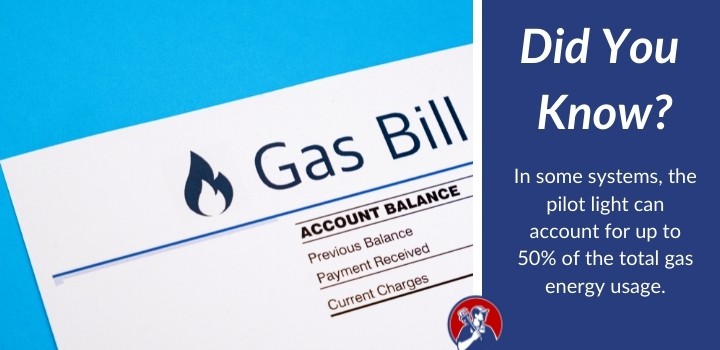
It’s a real pain when your hot water heater stops working. But it might be a simple fix. It can be as easy as relighting the gas pilot light!
Of course, other problems can cause the gas water heater to malfunction, but if it’s the water heater’s pilot light, we’ve got you covered.
By following these guidelines, you’ll soon have your hot water flowing.
| What's In This Guide? | |
|---|---|
Identify the Pilot Light on a Hot Water Heater
First, you will need to identify if your water heater is gas or electric powered. There is no pilot light on an electric water heater.
If it’s electric, all you need to do is reset the circuit breaker in your home. It should be labeled inside your electrical service panel.
Most electric water heaters also have their own reset button. You can find this out by looking in the service manual.
This article will focus on gas powered water heaters.
Before you can light the pilot light, you’ll need to locate it.
To locate the pilot light, look for a control knob or dial near the bottom of your water heater with markings labeled “Pilot,” “On,” and “Off.”
Finding Your Water Heater Model
To help identify where your specific water heater’s pilot light is located, check for any labels or stickers containing model information. This will allow you to search online for instructions tailored to your particular unit.
Get Fast, Local Plumbing Service
Connect with an expert plumber in your local area to tackle any job – big or small. Find help with leaks, clogs, or full installations.
Select your service category on the form, provide your details, and an expert plumber will be in touch!
Plumbing Navigator is an informational site that connects visitors with local plumbers but does not directly provide plumbing services or operate as a licensed company.
Different Types of Pilot Lights
It’s important to make sure which type you have before attempting to light the pilot.
- Standing Pilot: A standing pilot light features a small pilot flame that remains lit continuously. It requires no electricity and can be found in older gas water heaters.
- Electronic Ignition: Electronic ignition systems use an electric spark instead of a constantly burning small flame.
- Piezoelectric Igniter: A piezoelectric igniter creates sparks when you push a button, similar to many gas grills’ ignition systems.
Now that you have the necessary info about your specific model, and you know what type of pilot light it uses, you are almost ready to begin. The pilot light is crucial for your gas water heater “turning on.”
Pilot Light Safety Precautions
Before you attempt to light the pilot light on your water heater, you need to take some safety precautions:
- Turn off gas supply: Locate the gas shut-off valve knob near your water heater and turn it off. This step is crucial in preventing a potential gas leak while working with the pilot light.
- Warning: Immediately vacate the premises if a substantial gas leak is suspected, and contact your utility provider. Natural gas has no odor, so they add a chemical called mercaptan to give it that distinct rotten eggs odor.
- Gather necessary tools: You’ll need a flashlight, long lighter (or matches), and possibly an adjustable wrench depending on your water heater model.
- Familiarize yourself with instructions: Reviewing your water heater’s user manual can help guide you through this process.
- Not seeking help when needed: If you’re unsure about any part of this process or encounter difficulties while trying to light the pilot light on your gas heater, reach out to an experienced plumber.
Key Takeaway:
Before lighting the pilot light on your water heater, it’s important to take safety precautions such as stopping the gas flow to the main burner.

How to Re-light a Water Heater Pilot
Now that you have located the pilot light and taken the necessary safety precautions, it’s time to ignite the flame.
Follow these steps to successfully light your water heater’s pilot light:
Remove access panel (if applicable): Some water heaters have an access panel that needs to be removed before lighting the pilot light. If yours does, remove this panel according to the manufacturer’s instructions.
- Turn off the gas valve: Before igniting the pilot light, make sure that the gas control knob is in its “OFF” position for at least five minutes. This will allow any residual gas fumes to dissipate.
- Set temperature dial to lowest setting: Turn down your water heater’s temperature dial or thermostat to its lowest setting.
- Select “Pilot” mode on the control knob: Locate your water heater’s control knob and turn it from “OFF” to “PILOT.”
- Ignite using manual or electronic ignition system: If you have a manual ignition system, use a long lighter or matchstick with an extended reach while pressing down on either a red button or holding down the control knob.
- Igniter Button: For those with an electronic ignition system (typically found in newer models), simply press and hold both buttons simultaneously until you hear clicking sounds indicating successful ignition.
- Maintain pressure on control knob/button(s): To keep your newly ignited flame lit, continue holding down the gas knob or buttons for about 30 seconds to a minute. This will allow the thermocouple (a safety device) to heat up and maintain an open gas line.
Watch this helpful video on how to light the pilot light of your water heater:
If you encounter difficulties igniting your water heater’s pilot light, seek professional assistance from a licensed plumber.
How to Check the Pilot Light on a Water Heater
If you’re still experiencing difficulties with your pilot light, there are several potential causes to consider.
A. Check the Gas Supply
First, ensure that your water heater has an adequate gas supply by checking if other gas appliances (like the furnace, fireplace, or any other gas appliance) in your home are functioning properly. If they aren’t working either, you may need to contact your gas supplier for assistance.
B. Inspect the Thermocouple
The thermocouple is a safety device that acts as a gas regulator valve. It controls the gas supply to the burner. A faulty thermocouple could be responsible for the pilot light not staying lit or turning off unexpectedly. Here’s how to inspect the thermocouple.
C. Clean Pilot Light Assembly & Burner Tube
Over time, dirt and debris can accumulate in the pilot light assembly or burner tube, affecting its performance.
Troubleshooting possible issues is an important part of home maintenance, and understanding how to check the pilot light on a water heater can help you keep your plumbing running smoothly.
If you think it’s time for a new hot water heater, you’ll find some useful information here.
Key Takeaway:
If you’re having trouble with your pilot light, check the gas supply and inspect the thermocouple, pilot light, and pilot tube.
How to Reset the Pilot Light on a Water Heater
You reset the pilot light the same way you relight it. Follow the above instructions for “how to relight a water heater.”
You can also relight your pilot light yourself, and it’s usually easy. By adhering to the steps laid out, you can safely relight your pilot light and get the hot water flowing.
Get Fast, Local Plumbing Service
Connect with an expert plumber in your local area to tackle any job – big or small. Find help with leaks, clogs, or full installations.
Select your service category on the form, provide your details, and an expert plumber will be in touch!
Plumbing Navigator is an informational site that connects visitors with local plumbers but does not directly provide plumbing services or operate as a licensed company.
FAQs for How to Light a Pilot Light
Can I relight my own pilot light water heater?
Yes, most homeowners can relight their own pilot lights. Follow proper safety precautions and the instructions provided by your specific model’s manual.
How to Reset the Pilot Light on a Water Heater
Resetting the pilot light is the same as relighting it. Follow the above procedures to get your gas burner going again.
The term “resetting” can be applied to an electric powered water heater — like resetting a circuit breaker when it overloads.
How do I know if my hot water heater is safe?
Hot water heater safety is very important. It’s best to have it inspected by a professional plumber. If you want an overview on water heater safety, you might find this helpful.
Meet Your Plumbing Navigator

About Plumbing Navigator
We’re passionate about all things plumbing, and love sharing tips, “how-to”, and reviewing the latest products to help make your project a success!
Learn More Plumbing Tips
Want to tackle more plumbing projects? Check out these helpful guides!






